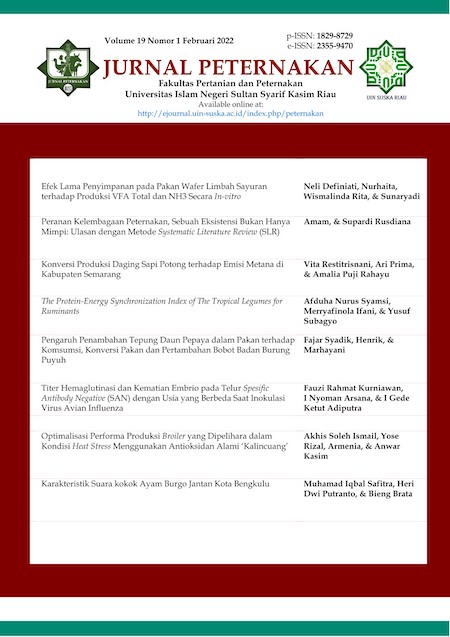Titer Hemaglutinasi dan Kematian Embrio pada Telur Spesific Antibody Negative (SAN) dengan Usia yang Berbeda Saat Inokulasi Virus Avian Influenza
DOI:
https://doi.org/10.24014/jupet.v19i1.15101Keywords:
Avian influenza, embryo death, hemagglutination titer, SAN eggs.Abstract
ABSTRAK. Penyakit Avian Influenza (AI) tidak hanya menginfeksi berbagai spesies unggas tetapi juga dapat menular ke manusia. Penelitian ini bertujuan untuk mengkaji titer hemaglutinasi dan kematian embrio pada telur Spesific Antibody Negative (SAN) dengan usia yang berbeda saat inokulasi virus Avian Influenza (AI). Penelitian menggunakan rancangan acak lengkap dengan empat perlakuan yaitu telur SAN usia 7 hari, 9 hari, 11 hari dan 13 hari. Perlakuan diulang sebanyak 6 kali sehingga total sampel telur SAN yang digunakan adalah sebanyak 24 telur. Hasil penelitian menunjukkan bahwa usia telur SAN berpengaruh secara signifikan terhadap titer hemaglutinasi dan waktu kematian embrio ayam. Rerata titer hemaglutinasi telur SAN usia 9; 11, dan 13 hari berturut-turut adalah 597,33 ± 85,33 HAU/25µl; 1.322,67 ± 339,73 HAU/25μl, dan 256 ± 85,86 HAU/25µl. Pada telur SAN usia 7 hari tidak ada titer hemaglutinasi pascainokulasi virus. Waktu kematian embrio pada telur SAN usia 7 terjadi satu hari pascainokulasi virus AI, sedangkan usia 9; 11, dan 13 hari terjadi dua hari pascainokulasi virus AI. Kesimpulan, titer hemaglutinasi dan kematian embrio telur SAN berbeda tergantung pada usia telur SAN, dan usia telur SAN yang paling baik digunakan untuk inokulasi virus AI adalah usia 11 hari.
Kata kunci: Avian influenza, kematian embrio, titer hemaglutinasi, telur SAN.
Hemagglutination Titers and Embryonic Death in Specific Antibody Negative (SAN) Eggs with Different Ages at The Time of Avian Influenza (AI) Virus Inoculation
ABSTRACT. Avian influenza (AI) not only infects various species of aves but also can be transmitted to humans. This study was aim to examine hemagglutination titers and embryonic death in Specific Antibody Negative (SAN) eggs with different ages at the time of Avian Influenza (AI) virus inoculation. The study used a completely randomized design with four treatment groups, namely SAN eggs 7 days old, 9 days, 11 days, and 13 days. The treatment was repeated 6 times so the total sample of SAN eggs used was 24 eggs. The results showed that the age of SAN eggs had a significant effect on the hemagglutination titer and the time of death of chicken embryos. Average hemagglutination titer SAN eggs age 9; 11, and 13 days respectively were 597.33 ± 85.33 HAU/25µl; 1,322.67 ± 339.73 HAU/25μl, and 256 ± 85.86 HAU/25µl. There was no hemagglutination titer in SAN eggs aged 7 days post-inoculation AI virus. The time of embryonic death in SAN eggs aged 7 occurred one-day post-inoculation AI virus, while age 9; 11, and 13 days occurred two days post-inoculation AI virus. In conclusion, hemagglutination titers and embryonic mortality differed depending on the age of the SAN eggs, and the best age to be used for AI virus inoculation was 11 days.
References
Affandi, F. 2007. Perkembangan embrio dari hari ke hari. CP-Bulletin Service A Tradition of Quality, Nomor 87/ Tahun VIII.
Fitriani., D. Masyitha., & M. Akmal. 2021. Histologis perkembangan embrio ayam pada masa inkubasi satu sampai tujuh hari. Jurnal Agripet. 21(1):65–70.
Hewajuli, D. A., N. L. P. I Dharmayanti & I. W. T Wibawan. 2017. deteksi, isolasi, dan identifikasi Avian influenza subtipe H5N1 pada unggas di Pulau Jawa, Indonesia tahun 2016. Jurnal Veteriner. 18(4):496. https://doi.org/10.19087/jveteriner.2017.18.4.496
Hewajuli, D.A., & N. L. P Dharmayanti,. 2008. Karakterisasi dan identifikasi virus Avian Influenza (AI). Wartazoa. 18(2):86–100.
Ilham, N., & Y. Yusdja. 2010. Dampak flu burung terhadap produksi unggas pendapatan peternak skala kecil di Indonesia. Jurnal Agro Ekonom. 28(1):39–68.
Kencana, G. A. Y., I. N Suartha., A. Nurhandayani & M. Ramadhan. 2014. Kepekaan telur Spesific Pathogen Free dan Clean Egg terhadap virus flu burung. Jurnal Veteriner. 15(1):87–93.
Mounts, A. W., H Kwong., H. S Izurieta., Y. Y Ho., T. K Au., M. Lee., C. B Bridges ., S. W Williams., K. H Mak., J. M Katz., W. M Thompson., N. J Cox & K. Fukuda. 1999. Case-control study of risk factors for avian influenza A (H5N1) disease, Hong Kong, 1997. Journal of Infectious Diseases, 180(2), 505–508. https://doi.org/10.1086/314903
OIE. 2021. Avian influenza (including infection with high patogenicity avian influenza viruses). Chapter 3.3.4. OIE Terrestrial Manual, 1–25.
Susanti, R., R. Soejoedono., I. G. N. K Mahardika., I. W. T Wibawan & M. T Suhartono. 2007. Potensi unggas air sebagai reservoir virus High Pathogenic Avian Influenza Subtipe H5N1. Ilmu Peternakan dan Veteriner. 12(2):160–166.
WHO. 2013. Serological detection of avian influenza A (H7N9) virus infections by modified horse red blood cells haemagglutination-inhibition assay. World Health Organization, December, 1-11.
WHO. 2021. Cumulative number of confirmed human cases for avian influenza A (H5N1) reported to WHO, 2003-2015. World Health Organization., January, 5–6.
Wibowo, H. M., W. Asmara & C. R Tabbu. 2006. Isolasi dan identifikasi serologis virus avian influenza dari sampel unggas yang diperoleh di D.I. Yogyakarta dan Jawa Tengah. Jurnal Sain Veteriner. 24 (1): 77–83.
Downloads
Published
Issue
Section
License
The Authors submitting a manuscript do so on the understanding that if accepted for publication, copyright of the article shall be assigned to Jurnal Peternakan and published by Fakultas Pertanian dan Peternakan Universitas Islam Negeri Sultan Syarif Kasim Riau as publisher of the journal.
Authors who publish with this journal agree to the following terms:
Authors automatically transfer the copyright to the journal and grant the journal right of first publication with the work simultaneously licensed under a Creative Commons (CC BY) that allows others to share the work with an acknowledgement of the work's authorship and initial publication in this journal.
Authors are able to enter into separate permission for non-exclusive distribution of the journal's published version of the work (e.g., post it to an institutional repository or publish it in a book), with an acknowledgement of its initial publication in this journal.
Authors are permitted and encouraged to post their work online (e.g., in institutional repositories or on their website) prior to and during the submission process, as it can lead to productive exchanges, as well as earlier and greater citation of published work (See The Effect of Open Access).

